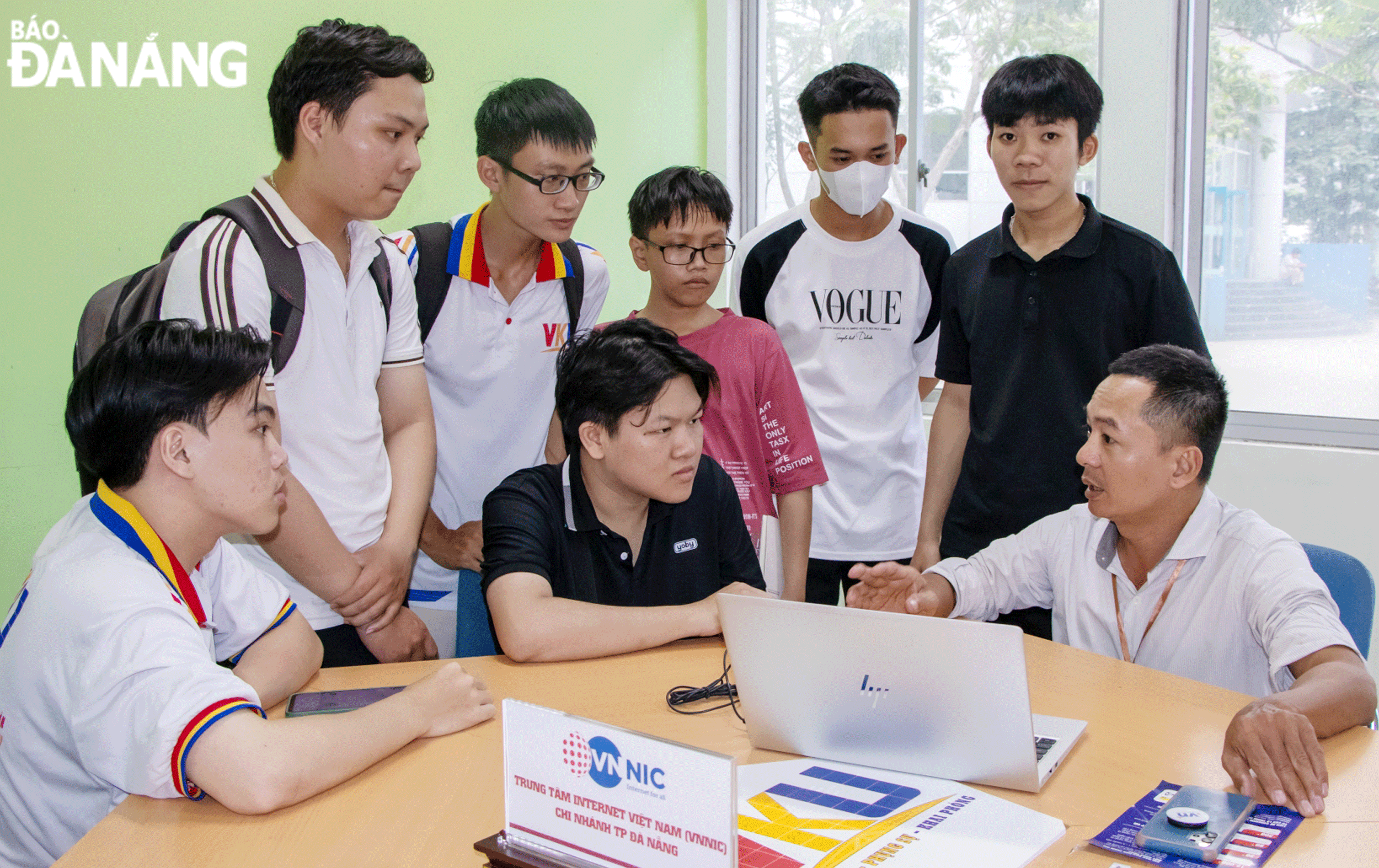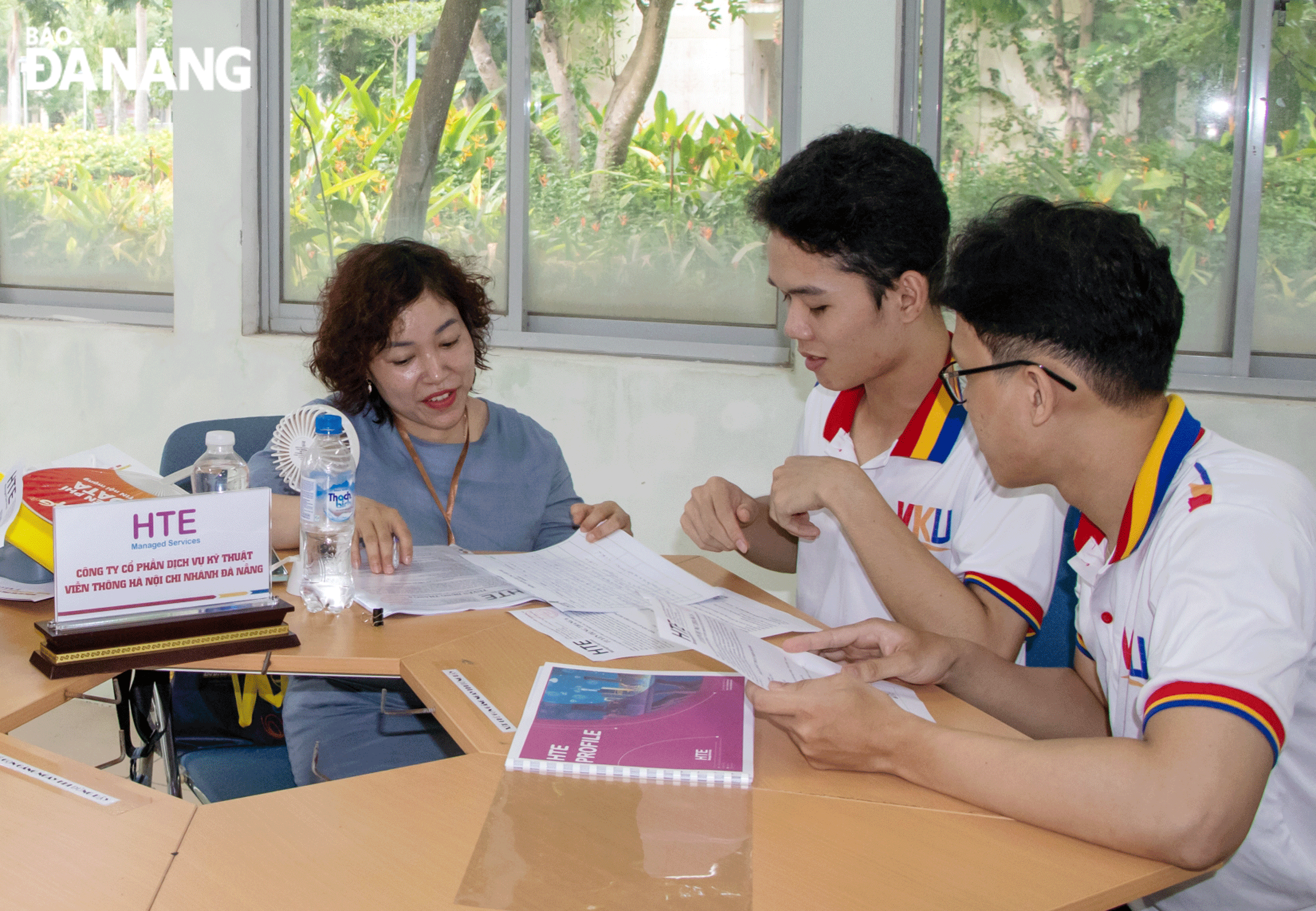Training specialised human resources to take lead in hi-tech labour market
Universities in Da Nang now provide abundant, high-quality technical and technological human resources for the labour market. However, in the face of increasingly fierce competition in the multi-platform, multimedia working environment, these educational establishments need to pay special attention to enhancing the quality of training in the 2024 - 2025 school year and the following years.
 |
| The tech industry, especially IT, is highly competitive, requiring both the quality of training from schools and the ability of students to self-study. Here is a scene of a job fair at the Viet Nam - Korea University of Information and Communication Technology. Photo: NGOC HA |
Attraction of engineering and high technology fields
As a major training centre in Viet Nam’s central region, and the whole country, with a team of well-trained lecturers, mainly graduated from advanced countries in the world and with a modern labouratory system, the University of Da Nang (UD) is always proactive in opening new training programmes to provide hi-tech human resources to meet social needs. Some outstanding majors that have been newly opened in the past three years include embedded systems and IoT, artificial intelligence (AI), information modeling and AI in construction, nanomaterials technology and microchip design.
In addition to new training programmes, the UD has enhanced the quality and quantity of hi-tech training majors to meet social needs such as information technology (IT) (nearly 1,000 enrollment slots at schools in 2024), control and automation engineering (330 slots), electronic and telecommunications engineering (270 slots), computer engineering (220 slots). In addition to full-time training to grant engineering and bachelor's degrees, the UD’s member schools now also coordinate with hi-tech companies to provide short-term training, specialised training according to business requirements and career transformation training.
“With the basic knowledge accumulated at school, engineers and technology graduates from the UD’s member schools can work in the right field of training, related fields and the same field group after graduation. Although there has not been graduates from the semiconductor chip training programme at the UD, according to current statistics, about 7% of the human resources working in the field of semiconductor chip design nationwide are former students graduating from the UD”, said Assoc. Prof., Dr. Le Thanh Bac, the UD Vice Rector.
 |
| A job fair at the Viet Nam - Korea University of Information and Communication Technology is in progress. Photo: NGOC HA |
Need to adapt at a higher level
Also according to Assoc. Prof., Dr. Le Thanh Bac, over recent years, Da Nang has been known as a centre for software technology development, especially focusing on developing the field of semiconductor chip design, alongside the two major cities Ho Chi Minh City and Ha Noi).
Revenue from software technology, for the time being, account for a large proportion of the city’s total. This positive result was mainly attributed to the presence of many domestic and foreign IT enterprises operating in the city.
One of the important factors attracting software development enterprises to operate in the city is the availability of abundant, quality IT human resources graduated from the UD and many other universities.
The National Assembly’s approval of Resolution No. 136/2024/QH15 on the organisation of urban government and piloting a number of specific mechanisms and policies for the development of Da Nang, including allowing the city to establish a free trade zone and a number of specific mechanisms and policies for its development, especially high technology, will be a big boost for Da Nang to attract large numbers of domestic and foreign investment, including in aspects in which the city shows of strengths and potential.
This is not only good news for the city’s government and people, but also an optimistic signal for university students, especially those with the majors of engineering and technology who are about to graduate and settle down in the city with many open job opportunities here.
However, Assoc.Prof., Dr. Le Thanh Bac noted that with the development of IT and good internet infrastructure, the working organisation model of global companies and domestic companies has recently undergone many major changes.
In particular, in the field of software development and microchip design, workers can work remotely and hold virtual meetings. Therefore, the concept of working close to the company no longer seems to be true when engineers can work and do application outsourcing for companies hundreds or thousands of kilometers away.
“This zero-distance working environment has created opportunities for software development and application design businesses to recruit talented people globally, creating opportunities for talented engineers and bachelors to find good jobs while still being close to home. However, this also requires hi-tech human resources to be ready to adapt and compete in a zero-distance working environment,” Assoc. Prof., Dr. Le Thanh Bac shared.
According to statistics from the Vietnamese Ministry of Information and Communications, about 70% of the total number of universities and junior colleges in Viet Nam offer training in IT. This shows Viet Nam’s efforts in expanding the supply of IT human resources. However, only one-thirds of the graduates meet the needs of the IT industry. Therefore, it’s high time for schools to considerably improve the quality of IT human resource training in the coming time.
Reporting by NGOC HA - Translating by A.THU, T.TUNG